The AN-ACC Integrated Data Model
March 31, 2022 | AN-ACC

The new AN-ACC funding model will bring with it an unprecedented connection between funding (case mix) and minimum care minutes.
- From October 2021, care minutes data was added to the annual ACFR information reported to the department.
- From July 2022, this reporting will become a quarterly requirement.
- In October 2022, the implementation of AN-ACC and the launch of the star rating system will introduce a new requirement to meet minimum care minutes derived from an AN-ACC case mix adjusted average for the facility.
- In October 2023, the care minute requirement will become a mandatory compliance requirement.
The paradigm shift for the industry is created by the connection of the care minute requirement to the AN-ACC classifications. This causal link means that any change in AN-ACC will directly affect the demand side of rostering. Further, any change in the resident mix will change the AN-ACC Average Daily Subsidy (ADS) and the care minute requirements. To maintain compliance with the star ratings or later mandatory care minute requirements, an adjustment to AN-ACC or to the rosters will need to be made.
But how do you ensure you have the data to support this decision-making process?
First, you need to look at admissions data.
This seems counter intuitive because surely AN-ACC and the rosters are more important. Visibility of your admissions pipeline, and your departures will help plan long range changes (6-8 weeks) to your AN-ACC and therefore care requirements. This is the foundation for your modelling. A fit-for-Aged Care CRM will be required to capture the required data efficiently and have it structured in a way that can be used for integration.
Next, you look at your workforce data.
Are your rosters stable? Have you defined all the types of shifts and whether they count towards care minute requirements? Do you meet the required minutes now? How does that affect your ideal model of care? What is the impact of increasing or decreasing care minutes? Stable, well defined master rosters and templates will help you flex and maintain compliance. A high-quality rostering platform will have dashboards for care minutes and allow easy extraction of quality care minute data for analysis.
Finally, you look at AN-ACC (Medicare) data.
This is last because it is the case mix that drives the potential funding and care minutes. Any change in the case mix adjusted average funding (ADS) will also adjust care minutes.
Now you can work through the formula.
- Are your admissions impacting your AN-ACC ADS? Up or down?
- Can you flex your rosters or do you need to keep them stable? Is this change within the planning horizon of your rosters or outside?
- Are there AN-ACC case mix adjustments you can make up or down to balance the other impacts?
- Which scenario has the best care/economic/operational outcome for the facility?
The last step is to create an efficient platform or system for managing the integrated data. Some systems will connect to each other (the Mirus platforms for example which includes modelling capability). Other systems may not and the integration of data may need to happen outside of the systems.
A further consideration is who will be the owner of the data. Some providers will have analytical skills in their Funding teams or Operations teams and this data analytics role could sit in that structure. Others may prefer this function to sit closer to Finance because of the impact on profitability as well as compliance and the reporting requirements.
A related consideration is the quality data.
To effectively manage performance and maintain current star rating, or to increase the rating, a combination of data is required.
The four components to the star rating are:
- care minutes,
- quality indicators,
- compliance ratings, and
- consumer experience.
An Integrated Data Model (IDM) for Aged Care will manage #1. The other three indicators are not necessarily directly related to AN-ACC or care minutes but will need to be reported and will combine to create the star rating.
Therefore, any modelling undertaken to achieve a desired star rating will need to also consider these data sets. The three extra data sets are more connected to each other.
Want to know more about the Integrated Data model?
Watch the Data-led decisions in an AN-ACC world webinar recording.
Have questions?


